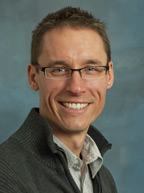NIH grant will study nutrition, physical activity in afterschool, summer programs as step to develop standards
September 9, 2011

Michael Beets of the Arnold School's Department of Exercise Science will partner with the YMCA of Columbia for an NIH grant to study nutrition and physical activity in afterschool and summer programs.
Every Monday through Friday in the United States, millions of American children spend significant amounts of time in afterschool programs. In the summer, they're likely to spend their days in organized programs, too.
Although participants eat snacks and are involved in activities with these programs, national standards don't tell what must be done to ensure that nutrition and activity levels meet the needs of the participants.
But a grant from the National Institutes of Health to researcher Dr. Michael Beets at the Arnold School of Public Health will be an important first step in developing, not only policies and standards for nutrition and activity in such programs, but easy-to- implement strategies to ensure such standards are met.
Beets will use the two-year grant to study nutrition and physical activity of children in afterschool and summer programs associated with the YMCA of Columbia, which has afterschool and summer programs in Lexington, Irmo, northeast Columbia (the Jeep Rogers YMCA) and Orangeburg.
"This study will enable us to establish policies for physical activity and nutrition for afterschool and summer programs and develop strategies to meet these policy goals," said Beets, an assistant professor in the Arnold School's Department of Exercise Science and an affiliated scholar with the Center for Research in Nutrition and Health Disparities.
The YMCA partnership is a good fit, said Beets.
"If you think about it, in the history of the United States, the YMCA represents one of the largest public health endeavors focused on promoting physical activity for people of all ages," he said. "Across the nation, the YMCA is recognized for its programs that encourage healthy lifestyles. Working with the YMCA of Columbia will enable us to develop standards and strategies for nutrition and physical activity in programs that reach children of all ages."
During the study, researchers will look at ways to reach parents with messages about packing healthy snacks and to involve staff members, who are role models to the youth, in modeling healthy behaviors, including eating their own healthy snacks and talking about healthy foods or leading young people in physical activity programs.
"Our intention is to develop model strategies that can be adopted for afterschool and summer programs and also adapted for other programs," he said.
The YMCA of Columbia afterschool program reaches about 500 youth across its four locations. The summer program at these locations serves about 500 young people each week.
An advantage in working with the YMCA is that the organization provides a variety of recreational programs in addition to its afterschool and summer programs. Nearly 10 million youth, ages 17 and under, are members of YMCA programs nationwide and about 32 million children, ages 14 and under, live within three miles of a YMCA facility. "The potential for outreach is amazing," he said.
The national standard for programs vary on the amount of afterschool time children should spend physically active. California law, for example, mandates students receive 30 minutes of activity in afterschool programs and North Carolina calls for students to be active about 20 percent of the time.
"People are interested in having benchmarks for their programs. But without empirical evidence, it is difficult to determine what these benchmarks should be," he said.
Depending on what activity young people are engaged in at school, during recess or physical education classes, afterschool programs may provide the only activity in a student's day – or may provide a significant amount of time toward reaching the 60-minute goal of moderate to vigorous activity daily for America's children.
The U.S. Department of Education estimates that about one-fifth of the nation's children in elementary and middle schools are in afterschool programs, and many of these are from low-income households.
"We have a great opportunity to promote physical activity and make changes in nutrition. This study is an important effort in improving the health of our nation's children and establishing healthy lifestyles for their future," Beets said.
Other USC researchers include Dr. Russ Pate, Department of Exercise Science, and Dr. Sonja Jones and Dr. Ruth Saunders, Department of Health Promotion, Education, and Behavior, all from the Arnold School; and Dr. Collin Webster, College of Education.



_01.jpg)
_02.jpg)